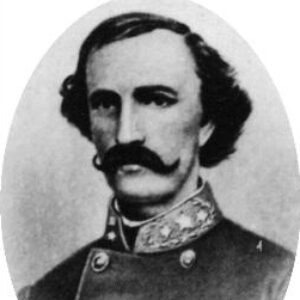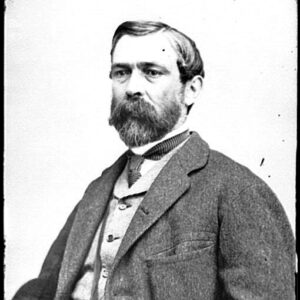calsfoundation@cals.org
Churchill’s Arkansas Division (CS)
The largest unit of Arkansas Confederate troops during the Civil War, this division saw action in both Arkansas and Louisiana. It was named for its commander, Major General Thomas James Churchill.
The first regiments that eventually belonged to the division were organized in the summer of 1862. After the Confederate defeat at the Battle of Pea Ridge in March 1862, Major General Earl Van Dorn led the majority of Confederate troops in the state east of the Mississippi River, where most remained for the duration of the war. Arkansas was left almost completely defenseless, and the new commander of the Trans-Mississippi Department, Major General Thomas C. Hindman, immediately began efforts to raise new units of troops in the state. Numerous companies were organized across the state and formed new regiments. Some of these units changed names or consolidated during the war, making it somewhat confusing to track their service.
The Federal Army of the Southwest moved across the state after its victory at the Battle of Pea Ridge, threatening to capture Little Rock (Pulaski County). Due to a lack of supplies and the need to establish reliable communication lines, the army captured Helena (Phillips County) in the summer of 1862. Another Federal force threatened to invade northwestern Arkansas from Missouri. After numerous complaints from civilians in the state about his heavy-handed efforts to prepare to defend Arkansas from Federal invasion, Hindman was removed from command of the Department of the Trans-Mississippi and took command of the District of Arkansas. In response to the Union troops moving into northwestern Arkansas, Hindman moved with his new units to Fort Smith (Sebastian County).
The Confederate army was divided into three divisions, each with multiple brigades. The brigades of Brigadier General James Fagan, Colonel Dandridge McRae, and Colonel Robert Shaver consisted of regiments that would later serve in the division. All three brigades fought at the Battle of Prairie Grove on December 7, 1862. The Confederates retreated back to Van Buren (Crawford County) after the engagement. The bulk of the army returned to Little Rock, where it reorganized. Individual unit losses for the battle are unknown. The regiments that fought at Prairie Grove (Washington County) were known for their commander during the battle but received official state designations in Little Rock.
January 1863 saw the capture of Fort Hindman, commanded by Brigadier General Thomas Churchill at Arkansas Post, along with the majority of the troops in the garrison. Part of the Nineteenth and Twenty-Fourth Arkansas Infantry regiments were not captured and eventually consolidated with other units to form a new regiment known as the Nineteenth/Twenty-Fourth Arkansas Infantry, which saw service in the division.
McRae was promoted to brigadier general and continued to lead his brigade, as did Fagan. Shaver was replaced as commander of his brigade by Brigadier General James Tappan. Tappan’s brigade served in northern Louisiana during the summer of 1863 and consisted of the Twenty-Seventh, Thirty-Third, and Thirty-Eighth Arkansas Infantry regiments. McRae’s brigade consisted of the Thirty-Second, Thirty-Sixth, and Thirty-Ninth Arkansas Infantry regiments, while Fagan’s brigade held the Thirty-Fourth, Thirty-Fifth, and Thirty-Seventh Arkansas Infantry regiments. Another regiment known both as the Thirty-Ninth Arkansas and Hawthorn’s regiment served in the brigade.
McRae and Fagan’s brigades saw action at the Battle of Helena on July 4, 1863. Together, the units lost ninety-three killed, 283 wounded, and 406 missing. The army retreated to Little Rock, where the units participated in the campaign to defend the city against a Federal assault. Retreating to southwestern Arkansas, the brigades reorganized. Churchill was reassigned to the Trans-Mississippi after time in a northern prison camp following his capture at Arkansas Post. After his release, he saw service in the Army of Tennessee before his transfer to Arkansas. He was first given command of a unit of Texas cavalry, but his failure at Arkansas Post made him unpopular with the troops, and he was given command of brigade previously commanded by Colonel Lucien Gause, who took command from McRae after the fall of Little Rock. The brigade consisted of the Twenty-Sixth, Thirtieth, Thirty-Second, and Thirty-Sixth Arkansas Infantry regiments and a battery of Arkansas artillery.
In March 1864, the infantry brigades stationed in southern Arkansas began to march to Shreveport, Louisiana, in response to a Federal army and fleet advancing up the Red River under the command of Major General Nathaniel Banks. As the units arrived in the city, the army was reorganized, and the Arkansas brigades formed a new division, while the units from Missouri were likewise organized. As the senior officer, Churchill took command of the new division. The first brigade of the division was commanded by Tappan and was composed of the consolidated Nineteenth and Twenty-Fourth Arkansas, the consolidated Twenty-Seventh and Thirty-Eighth Arkansas, and the Thirty-Third Arkansas. The second brigade was commanded by Gause and was the same as when Churchill commanded it. The final brigade was under the command of Brigadier General Alexander Hawthorn and likely consisted of the Thirty-Fourth, Thirty-Fifth, Thirty-Seventh, and Thirty-Ninth Arkansas Infantry regiments. While all of these units were severely understrength at this point of the war, they still held the largest concentration of Arkansas troops during the entire conflict.
Held in Shreveport by General Edmund Kirby Smith, the division prepared to either face the army advancing up the Red River or return to Arkansas to engage another Union force from Little Rock, under the command of Major General Frederick Steele, tasked with linking up with the other Federal army. Eventually, Smith sent the division to join Major General Richard Taylor and oppose Banks. The unit arrived during the Battle of Mansfield on April 8, 1864, and did not participate. Following the retreating Federal army southward, the division fought the next day at the Battle of Pleasant Hill, where it suffered twenty-six killed, 112 wounded, and sixty-three missing. During the battle, the division was commanded by Tappan, while Churchill commanded a wing of the army. The battle convinced Banks to continue his retreat, and Smith ordered Churchill’s division, along with a Missouri division and a Texas division, to return to Arkansas to face Steele.
The division returned to Shreveport and marched to Magnolia (Columbia County) before turning eastward to Camden (Ouachita County). The other two divisions took different routes to ease the strain that the men and animals would place on southern Arkansas. After meeting resistance at Elkins’ Ferry and Prairie D’Ane and facing a shortage of food, Steele captured Camden in order to rest and reorganize. After a forage train was captured west of the city at Poison Spring and another Union force was destroyed at Marks’ Mills, Steele decided to abandon Camden and return to Little Rock.
On the night of April 26, Steele abandoned Camden and began his retreat to Little Rock. Confederate forces worked to build a bridge across the Ouachita River, and Churchill’s division was the first unit to cross the stream early on the morning of April 28. With the Union army a full day’s march ahead, the division was pushed to make up the lost ground. The pace forced many men to fall out from exhaustion, depleting the already small unit. By the night of April 29, the division was at Tulip (Dallas County). Marching through rain and mud, the division reached the Federal army as it tried to cross the swollen Saline River at Jenkins’ Ferry. Attacking at 8:00 on the morning of April 30, the division was sent in one brigade at a time. Unable to make any headway against the Federals, the division was withdrawn later that morning and replaced first by the Missouri division and later the Texas division. The attacks were all unsuccessful, and the Union army was able to complete its crossing of the river and retreat to Little Rock. The casualty report from Hawthorn’s brigade is not available, but the other two brigades in the division lost fifty killed and 192 wounded out of an approximate strength of 2,000.
The brigades of the division were spread across southern Arkansas after the battle. Some units served at Camden and Princeton (Dallas County). In August, Churchill served as the temporary commander of the District of Arkansas, and Tappan commanded the division. The next month, the division was stationed near Monticello (Drew County), supporting parties scouting to Pine Bluff (Jefferson County). The unit also reorganized after Jenkins’ Ferry. In September, it consisted of four brigades commanded by Tappan, Hawthorn, Brigadier General John Roane, and Brigadier General Evander McNair. A battalion of artillery from Arkansas and Missouri was also attached to the division.
February 1865 found the division at Minden, Louisiana. Southern Arkansas could not support large numbers of troops and animals, and the army was spread out in order to provide some relief to the countryside. In March 1865, the division moved to Shreveport before marching to Marshall, Texas. On March 18, Churchill was promoted to major general. The division arrived on April 11 and began constructing a number of fortifications. It was at Marshall when the war ended. Before it surrendered, many men were furloughed to return to their homes in Arkansas and help with the wheat crop. The division was part of the general surrender of forces in the Trans-Mississippi in May.
For additional information:
Bearss, Edwin. Steele’s Retreat from Camden and the Battle of Jenkins’ Ferry. Little Rock: Pioneer Press, 1967.
Christ, Mark. Civil War Arkansas, 1863: The Battle for a State. Norman: University of Oklahoma Press, 2010.
Forsyth, Michael. The Camden Expedition of 1864 and the Opportunity Lost by the Confederacy to Change the Civil War. Jefferson, NC: McFarland, 2008.
———. The Red River Campaign of 1864 and the Loss by the Confederacy of the Civil War. Jefferson, NC: McFarland, 2002.
Shea, William. Fields of Blood: The Prairie Grove Campaign. Chapel Hill: University of North Carolina Press, 2009.
Sesser, David. “A Confederate Arkansan: The Civil War Career of Major General Thomas James Churchill.” MLA thesis, Henderson State University, 2011.
David Sesser
Henderson State University
 Military
Military Thomas Churchill
Thomas Churchill  Richard Taylor
Richard Taylor 




Comments
No comments on this entry yet.